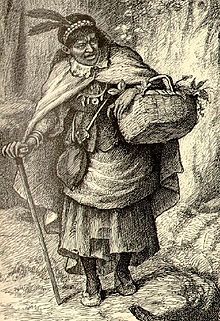Tituba
| Tituba | |
|---|---|

Illustration of Tituba by John W.
Ehninger, 1902 |
|
| Nationality | Carib |
| Other names | Tituba the Witch |
| Occupation | slave |
| Known for | Witchcraft (accused for being a Salem witch |
| Criminal charge | Witchcraft |
| Criminal penalty | Imprisonment |
| Spouse(s) | John Indian |
| Children | Violet |
Tituba was an enslaved woman, owned by Samuel Parris of Danvers, Massachusetts. Although her origins are debated, research has suggested that she was a South American native and sailed from Barbados to the United States with Samuel Parris. Tituba was the first to be accused of practicing witchcraft during the 1692 Salem witch trials. Little is known regarding Tituba's life prior to her enslavement. However, she became a pivotal figure in the witch trials when she confessed to witchcraft while also making claims that both Sarah Good and Sarah Osborne participated in said witchcraft. She was imprisoned and later released by Samuel Conklin, but little to nothing is known about Tituba's life following her subsequent release.
Tituba’s husband was John Indian, a native American man whose origins are unknown, but he may have been from Central America. Tituba as well may have been originally from Central America before Barbados. There are arguments made that Tituba was African American but this has been contradicted by historians including Breslaw partially blames Charles Upham for the confusion who got false information from Samuel drake. Her husband went on to become one of the accusers in the Witch Trials. They appear documented together in Samuel Parris’s church record book.
Tituba was the first person to be accused by Elizabeth Parris and Abigail Williams of witchcraft. It has been theorized that Tituba told the girls tales of voodoo and witchcraft prior to the accusations. She was also the first to confess to witchcraft in Salem Village. Initially denying her involvement in witchcraft, Tituba later confessed to making a "witchcake", due to being beaten by Samuel Parris with the intention of getting a confession. When questioned later, she added that she knew about occult techniques from her mistress in Barbados, who taught her how to ward herself from evil powers and how to reveal the cause of witchcraft. Since such knowledge was not meant for harm, Tituba again asserted to Parris she was not a witch, but admitted she had participated in an occult ritual when she made the witchcake in an attempt to help Elizabeth Parris. Despite these confessions, there is no proof that she did the things to which she confessed.
...
Wikipedia
